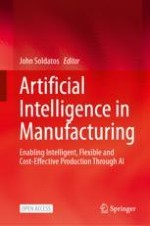Open Access 2024 | Open Access | Book

Artificial Intelligence in Manufacturing
Enabling Intelligent, Flexible and Cost-Effective Production Through AI
Editor: John Soldatos
Publisher: Springer Nature Switzerland
Open Access 2024 | Open Access | Book

Editor: John Soldatos
Publisher: Springer Nature Switzerland
This open access book presents a rich set of innovative solutions for artificial intelligence (AI) in manufacturing. The various chapters of the book provide a broad coverage of AI systems for state of the art flexible production lines including both cyber-physical production systems (Industry 4.0) and emerging trustworthy and human-centered manufacturing systems (Industry 5.0). From a technology perspective, the book addresses a wide range of AI paradigms such as deep learning, reinforcement learning, active learning, agent-based systems, explainable AI, industrial robots, and AI-based digital twins. Emphasis is put on system architectures and technologies that foster human-AI collaboration based on trusted interactions between workers and AI systems. From a manufacturing applications perspective, the book illustrates the deployment of these AI paradigms in a variety of use cases spanning production planning, quality control, anomaly detection, metrology, workers’ training, supply chain management, as well as various production optimization scenarios.
This is an open access book.